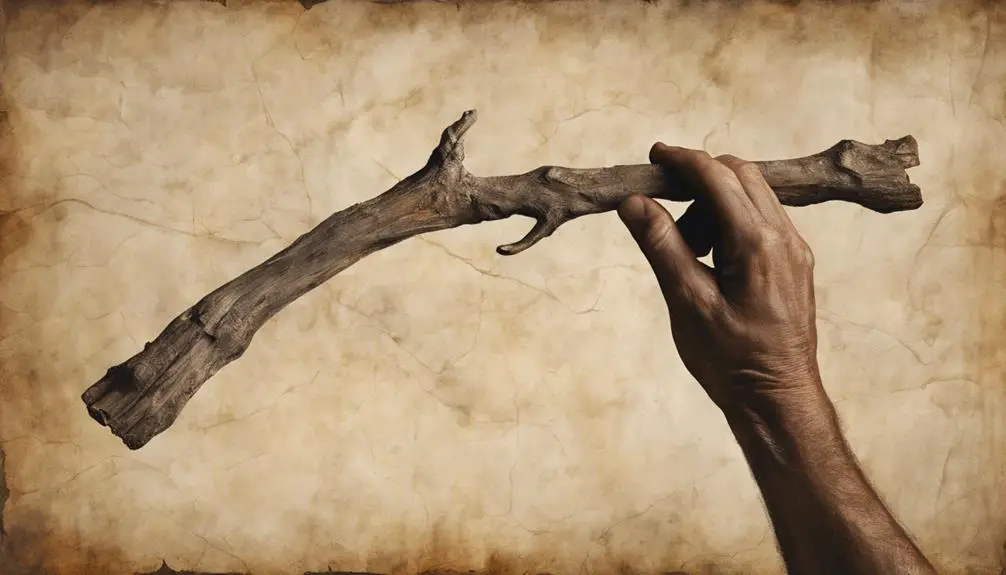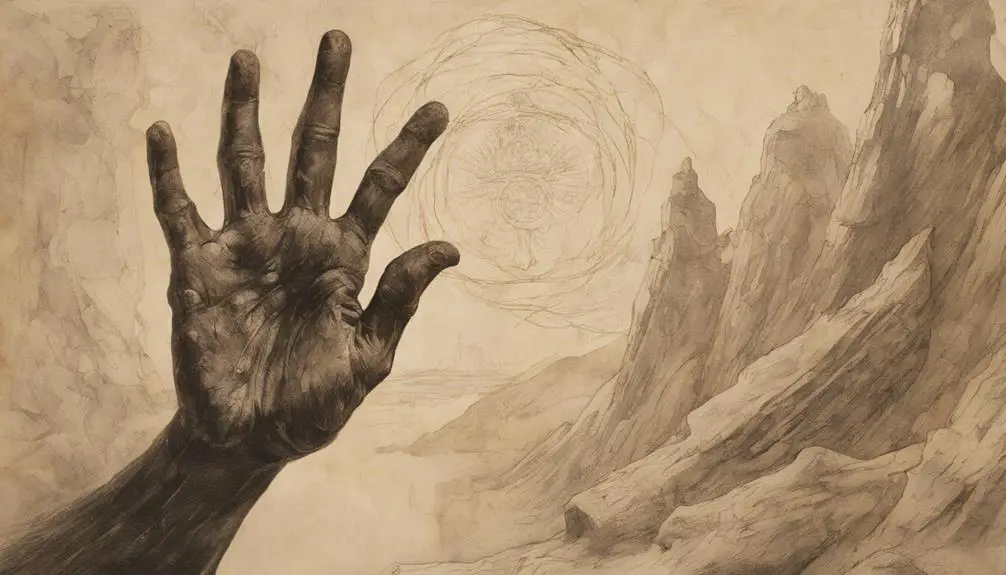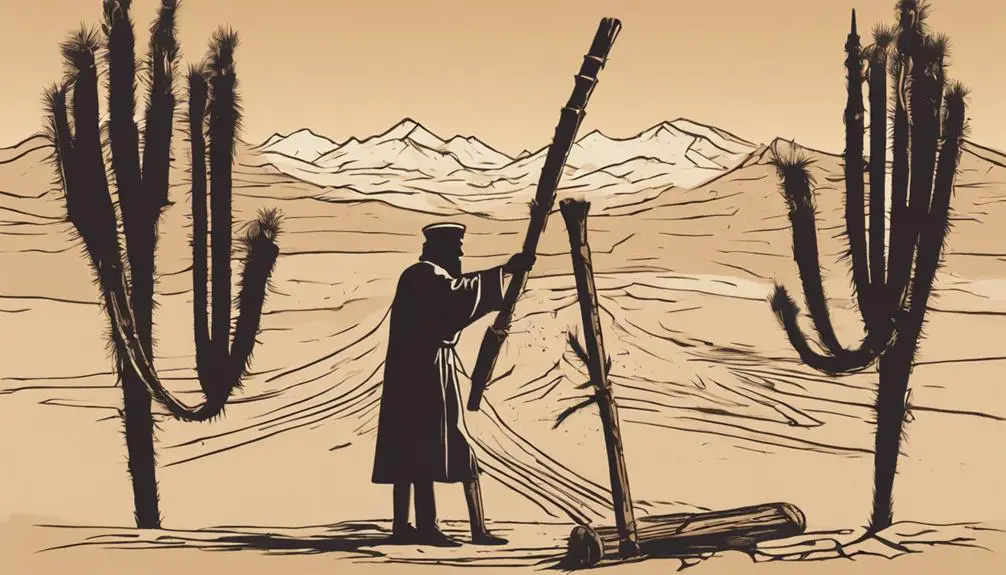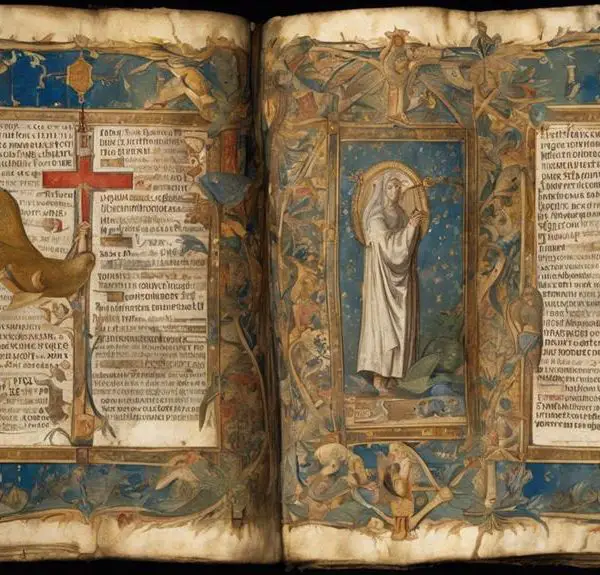Uncover the profound symbolism of sticks in the Bible, from divine power to leadership, in this intriguing exploration.

What Does a Stick Represent in the Bible
You've probably seen ancient frescoes of biblical figures brandishing sticks, but have you ever stopped to ponder what these simple wooden staffs symbolize in the biblical context?
Throughout the Bible, a stick, or more commonly referred to as a staff or rod, holds significant symbolic meaning. From Moses' staff that splits the Red Sea to Aaron's rod that buds, it's clear the stick isn't just a shepherd's tool. It's so much more.
Intriguing, isn't it? Stay tuned if you're curious to uncover the deeper, underlying messages these humble sticks convey.
Key Takeaways
- Sticks in the Bible symbolize divine authority, demonstrated through miracles like transformation into serpents.
- They represent God's endorsement of leadership, as seen with Aaron's rod and Moses' staff.
- Sticks also symbolize reconciliation and restoration, highlighted in Ezekiel's prophecy and Psalm 23.
- Lastly, they manifest divine intervention and providence, emphasizing God's active involvement in miraculous events.
The Symbolism of Moses' Staff

Delving into the symbolism of Moses' staff, you'll find it's not just a physical tool, but a profound emblem of divine authority and intervention in the Bible. This humble shepherd's staff becomes a conduit for God's miraculous power. The Staff Miracles aren't random, but deliberate displays of God's sovereignty over nature and human affairs.
In biblical interpretations, the staff's transformation into a snake during Moses' encounter with Pharaoh (Exodus 4:2-4), the parting of the Red Sea (Exodus 14:16), and the striking of the rock at Meribah (Numbers 20:8-11) all underscore its symbolic function. It's not the staff itself, but the divine power it channels that makes the miraculous possible.
However, the staff's symbolism goes beyond its supernatural exploits. It's also a sign of God's promise to guide, protect, and provide for His people. As you navigate through the Bible, you'll find that Moses' staff is more than a piece of wood. It's a tangible reminder of God's presence, a symbol of divine authority, and a testament to His ability to use ordinary things for extraordinary purposes.
Aaron's Rod: A Sign of Authority

Just as Moses' staff holds significant meaning, so too does Aaron's rod serve as a powerful symbol of divine authority in the Biblical narrative. You'll find Aaron's rod as the centerpiece of several 'Rod's Miracles,' each one underlining the priestly power invested in Aaron by God himself.
The rod's first divine demonstration occurs in Exodus 7:10-12, where it turns into a serpent before Pharaoh, proving God's dominion over creatures. This incident isn't just a show of power, it's a testament to the divine authority that backs Aaron's priestly role.
Another significant miracle takes place in Numbers 17, where Aaron's rod buds, blossoms, and produces almonds overnight. This miracle, you'll note, served a dual purpose. It not only ended the Israelites' rebellion against Aaron's priestly authority but also cemented his God-backed leadership.
These miracles performed by the rod aren't random acts of magic; they're divine confirmations of Aaron's priestly power. Thus, Aaron's rod in the Bible symbolizes a divine mandate, a heavenly endorsement of authority. It's a tangible proof that God's favor rests with those He chooses, and their authority comes directly from Him. The rod, therefore, stands as a sign of God's chosen authority.
The Stick in Ezekiel's Prophecy

While Aaron's rod symbolized divine authority, the stick mentioned in Ezekiel's prophecy carries a different, yet equally profound, symbolic meaning. This stick, or rather two sticks, is part of Ezekiel's Vision, specifically in Ezekiel 37:15-28. In this vision, the two sticks represent the divided kingdoms of Israel: Judah and Ephraim.
The prophet Ezekiel was instructed to take these two sticks, inscribe the names of the kingdoms on them, and join them together. This act is loaded with prophetic symbolism. It was a visual prophecy, illustrating God's future plan to reunite the divided nations into one.
In the context of this prophecy, a stick isn't just a piece of wood. It's a symbol of identity, destiny, and divine intervention. By joining the sticks together, Ezekiel was demonstrating God's intent to heal division, restore unity, and fulfill His promises. The stick in Ezekiel's prophecy, therefore, embodies hope, restoration, and the sovereign power of God to bring about His purposes, even amidst division and despair.
The Staff in Psalm 23's Context

In the 23rd Psalm, the staff emerges as a potent symbol of God's guidance and protection. It's a visual metaphor for the shepherd's protection, symbolizing the Divine Guidance that God offers to all his followers. Just as a shepherd uses his staff to guide and protect his flock, so too does God guide and protect His people.
You're encouraged to delve deeper into this analogy. The shepherd's staff isn't merely a physical instrument; it's a symbol of power and authority. It's the means by which the shepherd directs his sheep, keeping them on the right path and away from danger. This reflects the role of God as our spiritual shepherd, leading us through life's challenges and warding off threats.
When you observe the staff in this context, it underscores the comforting presence of God in our lives. It reassures us of His constant vigilance and care, just as a sheep feels safe under the watchful eye of its shepherd. Remember, the staff is more than a mere instrument; it's a powerful symbol of God's unwavering guidance and protection, a testament to His unyielding love for us.
Divine Intervention and the Stick

Exploring further, the stick referenced in various biblical passages often signifies divine intervention, serving as a tangible manifestation of God's power and providence in critical moments. When you delve into the narratives, you'll notice that the stick isn't merely an object; it's a symbol of divine authority and a conduit for miraculous occurrences.
One prominent example is Moses' staff, which played a pivotal role in the Exodus story. This wasn't just a shepherd's tool; it was the instrument through which God displayed His power, turning it into a snake or striking the Nile to bring forth the plagues. In these instances, staff symbolism goes beyond the ordinary, representing God's active intervention in human affairs.
Similarly, Aaron's budding staff in Numbers 17 is evidence of God's endorsement of his priesthood. It's not simply a walking stick that budded; it's a divine affirmation of leadership.
In both accounts, the stick's transformation signifies a shift from natural to supernatural, from mundane to miraculous. It's through such transformations that you see the stick as more than just a simple object, but rather a symbol of divine intervention and a testament to the profound mystery of God's active engagement in the world.
Frequently Asked Questions
Is There Any Significance of the Stick in the New Testament?"
Yes, there's significance to the stick in the New Testament. It's often used in stick metaphors and stick parables, symbolizing authority, punishment, and guidance.
For instance, in Matthew, a staff represents divine authority. Similarly, in Revelation, a rod signifies God's judgement. Thus, you'll find the stick is a powerful, recurring symbol throughout the New Testament, carrying diverse connotations depending on the context.
Does the Stick Symbolize Anything in the Book of Revelation?"
In the Book of Revelation, a stick doesn't hold a specific symbolic meaning. It's essential to understand that Revelation symbolism is rich with metaphors and allegories, but a 'stick' isn't notably present or interpreted as a significant symbol.
Don't confuse this with the 'stick prophecy' in Ezekiel, which is a different biblical context. Your focus should be on understanding the broader themes in Revelation, rather than seeking symbolism in every object.
How Does the Stick Relate to Jesus' Teachings in the Gospels?"
In the Gospels, stick metaphors often represent spiritual power or authority. When you connect this to Christ's teachings, you'll find that the stick can symbolize the divine authority or power that Jesus carried.
It's a physical representation of his spiritual influence and leadership. So, when you read about sticks in the Bible, think about Jesus's teachings and how they express his divine power and authority.
What Does the Stick Represent in Other Religions or Cultures Outside the Bible?"
In other cultures and religions, stick symbolism varies. In Islam, it's often seen as a tool of guidance, stemming from Moses' staff. It's also used in rituals like the 'stoning of the devil.'
Buddhist stick interpretations are different, associating it with the spiritual journey towards enlightenment, often carried by monks. Understanding these diverse interpretations helps you appreciate how universal symbols can carry unique meanings across different cultures and religions.
Are There Any Modern Interpretations or Symbolisms of the Stick in Christianity Today?"
In modern Christianity, stick symbolism mightn't be as prevalent, but it's still present. It's often seen as a symbol of authority, discipline, or guidance.
You might interpret it as a shepherd's staff, guiding the faithful. Or it could represent the rod of correction, a tool for discipline. While its usage has evolved, it's clear that the stick still holds significant meaning in modern Christian interpretations.
Conclusion
In summary, you've seen how a stick in the Bible isn't just a piece of wood. It symbolizes divine authority, as seen in Aaron's rod and Moses' staff.
It represents unification in Ezekiel's prophecy, and comfort and guidance in Psalm 23.
Indeed, a stick in the Bible serves as a powerful indicator of divine intervention, reinforcing the omnipresent role of God in guiding and shaping the course of human events.



Sign up